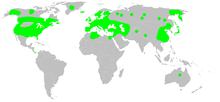Larinioides cornutus
| Larinioides cornutus | |
|---|---|

| |
| Scientific classification | |
| Kingdom: | |
| Phylum: | |
| Class: | |
| Order: | |
| Family: | |
| Genus: | |
| Species: | L. cornutus
|
| Binomial name | |
| Larinioides cornutus | |

| |
| Synonyms | |
| |
Larinioides cornutus, the furrow spider,[1] furrow orb spider, or foliate spider[2] is an orb-weaver spider with Holarctic distribution.
Females reach a body length of about 6–14 mm, males up to 5–9 mm. Leg spans range from 18 to 35 mm.[1]
These spiders are most often found in moist areas, especially near water. The web is built between grass or in low shrubbery. They hide during the day in a silken retreat that opens at the bottom, masked with plant and animal matter and leave it during the night. The web is remade in the evening.[3]
The male lives with the female during mating time, which is in autumn and again in spring. The female produces three to five yellow egg sacs during the summer.[3]
There is possibly a distinct species L. folium, which is very similar but occurs in dry habitat.[3]
References
External links
 Media related to Larinioides cornutus at Wikimedia Commons
Media related to Larinioides cornutus at Wikimedia Commons
